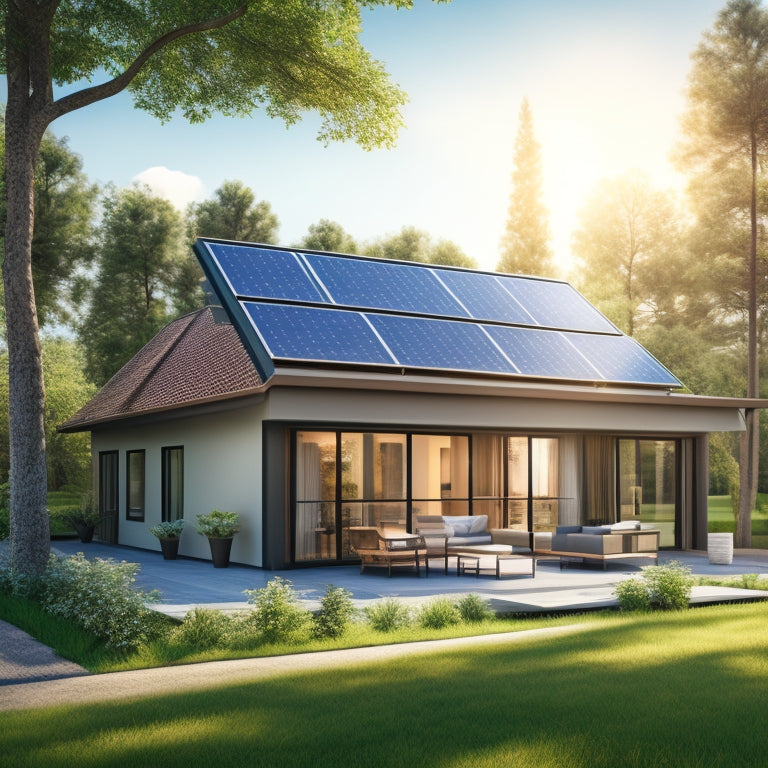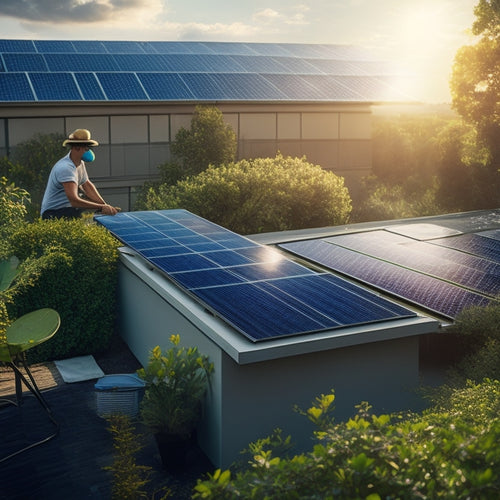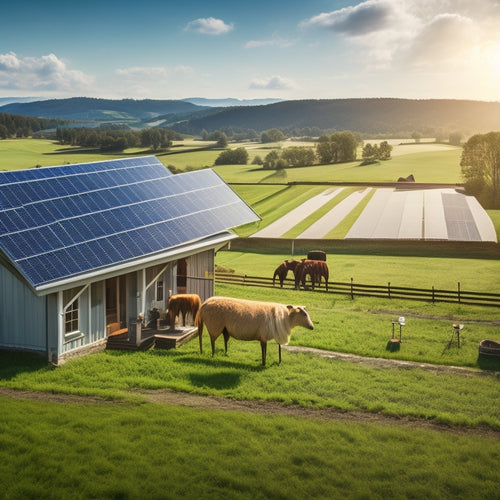
Calculate Your Residential Solar Panel Installation Cost
Share
To calculate your residential solar panel installation cost, start by considering panel quality, location, and incentives. Quality panels are more efficient but costlier. Location affects labor rates and regulatory fees. Urban areas often have higher labor costs. Don't forget hidden fees like permitting, potential electrical upgrades, and roofing work. Incentives such as federal tax credits and state rebates can greatly lower costs. Make sure your installer is certified and offers a thorough warranty for long-term performance. By understanding these factors, you get a clearer picture of your investment and potential savings, revealing more details on optimizing your solar setup.
Key Takeaways
- Assess hidden costs like permitting fees, electrical upgrades, and potential roofing work.
- Evaluate panel quality and efficiency to determine long-term energy savings and installation costs.
- Consider regional factors such as labor rates, government incentives, and climate conditions.
- Compare incentives and rebates like federal tax credits, state incentives, and utility programs to lower overall costs.
- Get quotes from certified professionals for accurate labor fees, installation complexity, and warranty coverage.
Understanding Installation Costs
https://www.youtube.com/watch?v=cVT5HAjrHZM
Calculating the cost of installing residential solar panels involves understanding several key factors that can influence the total investment. You can't just look at the price of the panels themselves; you need to dig deeper. Hidden costs often catch homeowners off-guard. These can include permitting fees, electrical upgrades, and potential roofing work. Don't let these surprise expenses take away from the freedom that solar energy promises.
Vital details are another essential aspect you shouldn't overlook. A thorough warranty will safeguard your investment and guarantee long-term performance. Typically, solar panels come with a 25-year performance warranty, but the fine print matters. Some warranties only cover specific issues, like manufacturing defects, but not installation errors or environmental damage. Knowing what's covered can save you from unexpected repair costs down the line.
Factors Affecting Pricing
You'll find that the cost of residential solar panel installation varies greatly based on several key factors.
Your location, the quality of the panels you choose, and the availability of incentives and rebates all play important roles in determining the final price.
Understanding these variables can help you make a more informed and cost-effective decision.
Installation Location Impact
Your solar panel installation costs can vary greatly depending on the specific location of your property due to factors like regional labor rates, local government incentives, and climate conditions.
Regional regulations play an essential role in determining the final price. Different states and municipalities have unique rules and requirements for solar installations that can either simplify or complicate the process, directly impacting your expenses. Some areas might offer generous incentives or tax breaks that can greatly reduce the overall cost, while others might've stringent codes requiring additional materials or specialized labor.
Weather conditions are another important factor. If you live in a region with frequent storms or heavy snowfall, your installation might necessitate more robust, and thus more expensive, equipment to ensure durability and efficiency. Conversely, sunnier climates may allow for a simpler, more cost-effective setup.
Additionally, the local cost of labor can vary widely. Urban areas often have higher labor costs compared to rural settings, largely due to the higher cost of living.
Panel Quality Variations
The quality of the solar panels you choose greatly impacts the overall cost of installation, as higher-quality panels typically offer greater efficiency and longer lifespans. When evaluating your options, consider that panels with higher efficiency can convert more sunlight into electricity, enabling you to generate more power and achieve higher energy savings. Although these panels usually come with a steeper price tag, their superior performance can result in lower long-term costs.
Investing in premium panels often means benefiting from an extended warranty period. Manufacturers of top-tier panels frequently offer warranties that span 25 years or more. This guarantees that your investment is protected and ensures consistent performance over time. On the other hand, lower-quality panels may have shorter warranties, potentially leading to higher maintenance and replacement costs down the line.
When it comes to liberation from energy dependence, choosing higher-quality panels is a strategic move. The enhanced panel efficiency translates into more autonomy and less reliance on external power sources. By opting for the best panels available, you're not just making a purchase; you're securing a future of sustainable, independent energy production.
Incentives and Rebates
Many governmental and regional programs offer attractive incentives and rebates that greatly reduce the overall cost of installing residential solar panels. These financial aids can make a significant difference, allowing you to liberate yourself from high utility bills and embrace renewable energy with less financial strain.
Here are three key types of incentives:
-
Government Grants: Direct financial assistance that can substantially lower your initial investment. These grants are often available at both federal and state levels, aiming to promote clean energy adoption.
-
Tax Credits: Federal and state tax credits can dramatically decrease your tax liability. The Investment Tax Credit (ITC) allows you to deduct a significant percentage of your solar installation costs from your federal taxes.
-
Rebates: Local utility companies and state governments frequently offer rebates to solar adopters. These rebates can be applied directly to the purchase and installation costs, reducing the financial burden.
Understanding and leveraging these incentives can make solar panel installation not just affordable but also a financially sound decision. Dive into the details of these programs to maximize your savings and take a decisive step towards energy independence.
Calculating Solar Needs
To accurately calculate your solar needs, start by evaluating your energy consumption to determine the system size required.
Next, measure your available roof space to confirm it can accommodate the panels.
Assess Energy Consumption
Understanding your household's energy consumption is essential for accurately calculating your solar needs. Begin with a thorough energy audit to identify how much power you use and when. This audit will reveal consumption trends and help you understand your peak usage times, allowing you to size your solar system efficiently.
Here's how to get started:
-
Review Your Electricity Bills: Gather the last 12 months of electricity bills to analyze your monthly and annual consumption in kilowatt-hours (kWh). Look for patterns, such as seasonal spikes in usage.
-
Identify Major Energy Users: List out appliances and systems that consume the most energy, such as HVAC units, water heaters, and refrigerators. Knowing these helps pinpoint areas for efficiency improvements.
-
Monitor Daily Usage: Use smart meters or energy monitoring tools to track your daily kWh usage. This real-time data provides insights into your consumption habits and can highlight opportunities for reducing waste.
Determine Roof Space
Accurately evaluating your available roof space is crucial for determining the size and efficiency of your residential solar panel system. Begin by measuring your roof dimensions meticulously. Knowing the exact length and width of your roof helps you calculate the total surface area, providing a clear picture of how many solar panels you can install.
Next, think about space optimization. Not all roof areas are equally suitable for solar panels. Consider any obstructions like chimneys, vents, or skylights that may limit usable space. Also, assess the roof's shape and pitch. A south-facing, flat, or gently sloped roof will maximize solar energy capture.
You should also use a professional tool or consult with a solar installation expert to create a detailed roof layout. This ensures that every inch of your available roof space is utilized efficiently. By optimizing the space, you can install more panels, ultimately generating more energy and increasing your savings.
In essence, accurately measuring your roof dimensions and focusing on space optimization is a crucial step toward achieving energy independence and financial freedom through solar power. This meticulous planning aligns with your desire for liberation from traditional energy sources.
Evaluate Sunlight Exposure
Evaluating sunlight exposure is crucial for calculating your solar needs and ensuring maximum energy production from your residential solar panel system. Optimizing your system starts with understanding how much sunlight your location gets and the angles at which the sun's rays strike your panels. This affects your system's efficiency and, ultimately, your energy savings.
Here are three key factors to take into account:
-
Sunlight Duration: Measure the hours of direct sunlight your roof receives daily. This varies by season and geography, greatly impacting your solar energy output.
-
Solar Angle: Determine the best tilt for your panels based on your latitude. Proper alignment ensures that your panels capture the most sunlight throughout the year.
-
Shading Analysis: Identify any potential obstructions like trees, buildings, or chimneys that could block sunlight. Even minor shading can significantly reduce your system's performance.
Comparing Panel Options
When comparing solar panel options, you'll want to take into account efficiency, durability, and cost to make sure you get the best value for your investment.
Start by examining different brand preferences. Established brands often have higher efficiency ratings, which means they convert more sunlight into electricity. This can make a significant difference in your overall energy production, especially if your roof space is limited.
Efficiency ratings are essential. Panels with higher ratings may cost more upfront, but they usually offer better long-term savings by generating more power per square foot. Look for panels with efficiency ratings of at least 18-20%. These panels usually come with solid warranties, ensuring their durability over the years.
Durability is also important. You don't want to invest in panels that'll degrade quickly. Check for panels that have a robust build and strong resistance to weather conditions. High-quality panels often come with warranties that last 25 years or more, providing peace of mind.
Installation and Labor Fees
Once you've chosen the right panels, it's time to factor in the installation and labor fees to understand the full scope of your investment. These costs can vary greatly, but they're important for a smooth shift to solar energy.
To make sure you get the best value, consider the following:
-
Contractor Selection: Choosing a reputable contractor is vital. Look for certified professionals with extensive experience in solar installations. Check reviews, ask for references, and compare quotes to make certain you're getting the best deal.
-
Warranty Coverage: Examine the warranty coverage offered by the contractor. A thorough warranty can protect you from future maintenance costs and give you peace of mind. Make sure it covers both the installation work and the panels themselves.
-
Labor Fees: Labor fees can range from $3,000 to $10,000, depending on the complexity of your installation. This includes the cost of mounting the panels, electrical work, and connecting your system to the grid. Always get a detailed breakdown of labor charges to avoid hidden fees.
Financing and Incentives
Understanding the financing options and incentives available for residential solar panel installations can greatly reduce your overall investment and expedite your shift to renewable energy. With the right financial strategy, you can harness the sun's power without breaking the bank.
Firstly, explore various loan options tailored specifically for solar energy projects. Many financial institutions offer solar loans with competitive interest rates, enabling you to spread out the cost over several years. These loans can be secured or unsecured, so it's essential to compare terms and choose the one that best fits your financial situation.
Next, take advantage of federal and state tax credits designed to lower your initial costs. The Federal Investment Tax Credit (ITC) allows you to deduct a significant percentage of your solar installation expenses from your federal taxes. Some states offer additional incentives, such as rebates or performance-based incentives, which can further reduce your net expenditure.
Moreover, some utility companies provide net metering programs, crediting you for excess electricity your system generates. This can offset your electricity bill and shorten your payback period.
Frequently Asked Questions
How Long Do Solar Panels Typically Last?
Solar panels typically last 25-30 years. You'll experience minimal lifespan degradation over this period. Most come with warranty terms guaranteeing performance, empowering you to rely on clean energy while ensuring your investment remains protected.
Can Solar Panels Increase My Property Value?
Did you know solar panels can boost property value by up to 4.1%? When appraisers consider your home's solar energy system, it often increases resale value, making your property more attractive to eco-conscious buyers.
What Maintenance Do Solar Panels Require?
For peak performance, establish a cleaning schedule to remove debris and dirt from your solar panels. Regular maintenance enhances efficiency and extends lifespan, empowering you to harness maximum energy independence.
Are There Any Potential Drawbacks to Installing Solar Panels?
You might wonder, are there any potential drawbacks to installing solar panels? The initial investment can be considerable, and energy storage solutions add to the cost. However, the long-term benefits and energy independence often outweigh these concerns.
How Do Solar Panels Affect My Home Insurance?
Solar panels might raise your insurance premiums, but they also boost your home's value. Confirm your policy includes coverage types that protect the panels themselves. With the right coverage, you're safeguarding both your investment and your freedom.
Related Posts
-

Green Ways to Maintain Solar Panels
To maintain your solar panels sustainably, start with regular inspections to catch potential issues early, enhancing ...
-

Solar Power Systems for Rural Properties
Solar power systems offer a reliable and efficient energy solution for rural properties, allowing you to gain energy ...
-

Eco-Friendly Home Design Ideas for Beginners
If you're starting your eco-friendly home design expedition, focus on sustainable materials like recycled wood or rec...


